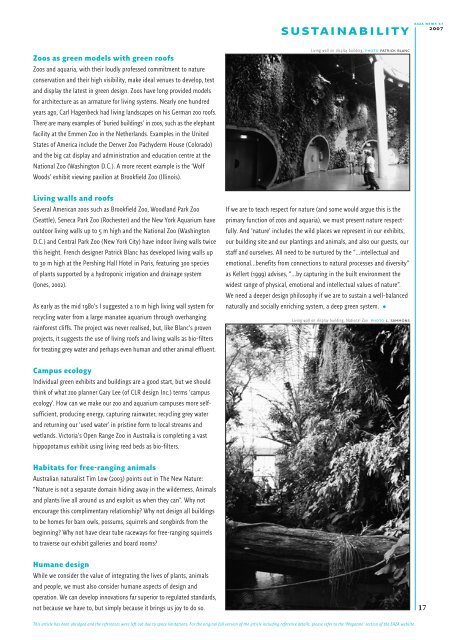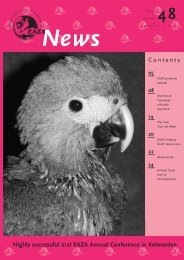EAZA News 57-12 - European Association of Zoos and Aquaria
EAZA News 57-12 - European Association of Zoos and Aquaria
EAZA News 57-12 - European Association of Zoos and Aquaria
You also want an ePaper? Increase the reach of your titles
YUMPU automatically turns print PDFs into web optimized ePapers that Google loves.
<strong>Zoos</strong> as green models with green ro<strong>of</strong>s<br />
<strong>Zoos</strong> <strong>and</strong> aquaria, with their loudly pr<strong>of</strong>essed commitment to nature<br />
conservation <strong>and</strong> their high visibility, make ideal venues to develop, test<br />
<strong>and</strong> display the latest in green design. <strong>Zoos</strong> have long provided models<br />
for architecture as an armature for living systems. Nearly one hundred<br />
years ago, Carl Hagenbeck had living l<strong>and</strong>scapes on his German zoo ro<strong>of</strong>s.<br />
There are many examples <strong>of</strong> ‘buried buildings’ in zoos, such as the elephant<br />
facility at the Emmen Zoo in the Netherl<strong>and</strong>s. Examples in the United<br />
States <strong>of</strong> America include the Denver Zoo Pachyderm House (Colorado)<br />
<strong>and</strong> the big cat display <strong>and</strong> administration <strong>and</strong> education centre at the<br />
National Zoo (Washington D.C.). A more recent example is the ‘Wolf<br />
Woods’ exhibit viewing pavilion at Brookfield Zoo (Illinois).<br />
Living walls <strong>and</strong> ro<strong>of</strong>s<br />
Several American zoos such as Brookfield Zoo, Woodl<strong>and</strong> Park Zoo<br />
(Seattle), Seneca Park Zoo (Rochester) <strong>and</strong> the New York Aquarium have<br />
outdoor living walls up to 5 m high <strong>and</strong> the National Zoo (Washington<br />
D.C.) <strong>and</strong> Central Park Zoo (New York City) have indoor living walls twice<br />
this height. French designer Patrick Blanc has developed living walls up<br />
to 30 m high at the Pershing Hall Hotel in Paris, featuring 300 species<br />
<strong>of</strong> plants supported by a hydroponic irrigation <strong>and</strong> drainage system<br />
(Jones, 2002).<br />
As early as the mid 1980’s I suggested a 10 m high living wall system for<br />
recycling water from a large manatee aquarium through overhanging<br />
rainforest cliffs. The project was never realised, but, like Blanc’s proven<br />
projects, it suggests the use <strong>of</strong> living ro<strong>of</strong>s <strong>and</strong> living walls as bio-filters<br />
for treating grey water <strong>and</strong> perhaps even human <strong>and</strong> other animal effluent.<br />
Campus ecology<br />
Individual green exhibits <strong>and</strong> buildings are a good start, but we should<br />
think <strong>of</strong> what zoo planner Gary Lee (<strong>of</strong> CLR design Inc.) terms ‘campus<br />
ecology’. How can we make our zoo <strong>and</strong> aquarium campuses more selfsufficient,<br />
producing energy, capturing rainwater, recycling grey water<br />
<strong>and</strong> returning our ‘used water’ in pristine form to local streams <strong>and</strong><br />
wetl<strong>and</strong>s. Victoria’s Open Range Zoo in Australia is completing a vast<br />
hippopotamus exhibit using living reed beds as bio-filters.<br />
Habitats for free-ranging animals<br />
Australian naturalist Tim Low (2003) points out in The New Nature:<br />
“Nature is not a separate domain hiding away in the wilderness. Animals<br />
<strong>and</strong> plants live all around us <strong>and</strong> exploit us when they can”. Why not<br />
encourage this complimentary relationship? Why not design all buildings<br />
to be homes for barn owls, possums, squirrels <strong>and</strong> songbirds from the<br />
beginning? Why not have clear tube raceways for free-ranging squirrels<br />
to traverse our exhibit galleries <strong>and</strong> board rooms?<br />
Humane design<br />
While we consider the value <strong>of</strong> integrating the lives <strong>of</strong> plants, animals<br />
<strong>and</strong> people, we must also consider humane aspects <strong>of</strong> design <strong>and</strong><br />
operation. We can develop innovations far superior to regulated st<strong>and</strong>ards,<br />
not because we have to, but simply because it brings us joy to do so.<br />
D<br />
sustainability<br />
Living wall on display building, photo patrick blanc<br />
If we are to teach respect for nature (<strong>and</strong> some would argue this is the<br />
primary function <strong>of</strong> zoos <strong>and</strong> aquaria), we must present nature respectfully.<br />
And ‘nature’ includes the wild places we represent in our exhibits,<br />
our building site <strong>and</strong> our plantings <strong>and</strong> animals, <strong>and</strong> also our guests, our<br />
staff <strong>and</strong> ourselves. All need to be nurtured by the “…intellectual <strong>and</strong><br />
emotional…benefits from connections to natural processes <strong>and</strong> diversity”<br />
as Kellert (1999) advises, “…by capturing in the built environment the<br />
widest range <strong>of</strong> physical, emotional <strong>and</strong> intellectual values <strong>of</strong> nature”.<br />
We need a deeper design philosophy if we are to sustain a well-balanced<br />
naturally <strong>and</strong> socially enriching system, a deep green system. •<br />
Living wall on display building, National Zoo photo l. sammons<br />
This article has been abridged <strong>and</strong> the references were left out due to space limitations. For the original full version <strong>of</strong> the article including reference details, please refer to the ‘Magazine’ section <strong>of</strong> the <strong>EAZA</strong> website.<br />
eaza news <strong>57</strong><br />
2007<br />
17

















